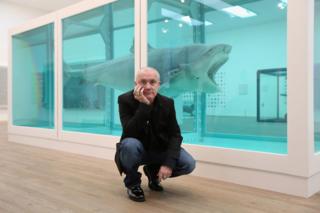Damien Hirst formaldehyde artworks ‘posed no risk to public’
 Image copyright
Image copyright
Getty Images
Tate Modern’s Damien Hirst retrospective was one of its most-visited exhibitions
A scientific paper that claimed a 2012 exhibition of Damien Hirst works led to the release of formaldehyde fumes has been retracted by one of its authors.
The report said gas levels at the Tate Modern exhibition – which included dead animals preserved in giant tanks – were above those legally permitted.
The claims were investigated by Hirst’s Science Ltd company, which conducted more tests on his formaldehyde pieces.
The results found there was “never any risk to the public”, as was alleged.
It has led Prof Pier Giorgio Righetti – one of the authors of the paper published in April in the Royal Society of Chemistry’s Analytical Methods Journal – to acknowledge his paper was “inaccurate and unreliable”.
A spokesperson for Science Ltd and Prof Righetti said the professor “regret[ted] any alarm or concern the paper may have caused”.
‘Discrepancy’
They added Hirst “cooperated” to conduct further tests on his works following April’s report. which all showed formaldehyde readings lower than 0.1 ppm (parts per million). The recommended maximum exposure level under legislation is 2 ppm.
“The cause of the discrepancy with the readings published in the paper was identified and it was agreed that there cannot have been formaldehyde present at the dangerously high levels originally cited,” the spokesperson said.
BBC arts editor Will Gompertz was among those to report on the claims, in an edition of Radio 4’s Today programme broadcast on 21 April.
Tate Modern’s Damien Hirst retrospective was the most-visited solo show and the second-most visited exhibition in the London gallery’s history. It included a shark suspended in formaldehyde titled The Physical Impossibility of Death in the Mind of Someone Living plus a bisected cow and calf in four parts called Mother and Child (Divided).
Follow us on Twitter @BBCNewsEnts, on Instagram at bbcnewsents, or email [email protected].